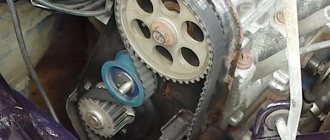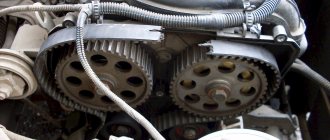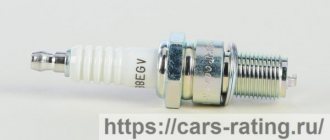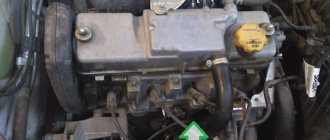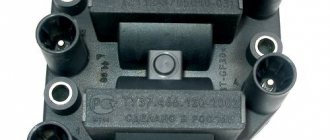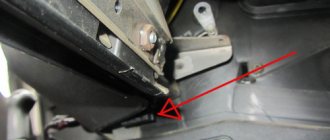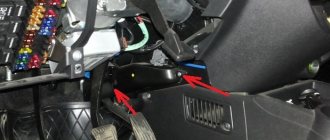Purpose of the water pump
The main function of the water pump is to maintain the timing belt and move antifreeze through the engine cooling system. In turn, the cooling system is designed to ensure the required circulation of antifreeze, cooling the power unit and providing its parts with protection from possible overheating. The lack of cooling makes the normal functioning of the motor impossible, since even minimal loads in this case lead to instant heating and subsequent boiling of the power unit.
The pump operates thanks to the drive from the timing belt. The operation of the entire cooling system is structured as follows: first, coolant is poured into the expansion tank, and after the engine is started, it enters the pump cavity. The pump operates in a temperature range from - 40oC to + 40oC with air humidity up to 90%.
Addresses of companies providing services for the replacement and installation of water pumps (Moscow, St. Petersburg, Kyiv region)
| № | Name | Address |
| 1. | "Carfix" | Moscow, Shabolovka street, 31сБ |
| 2. | "AVS-MSK" | MOSCOW, VAO st. PEROVSKAYA 1 (metro Shosse Entuziastov) |
| 3. | "MT-AVTO" | St. Petersburg, St. Siqueiros, 14, St. Yesenina, 19, st. Mineralnaya, 30A |
| 4. | "SPB.ZOON" | 191186, St. Petersburg, Nevsky Prospekt, 11, office 44, Telephone |
| 5. | "AutoSTOPZhuliany" | Kyiv, st. Sadovaya, 56 Zhulyany |
| 6. | "Italmotors Ukraine" | st. Ring road, 14, Kyiv |
Symptoms of pump failure
The resource of a modern water pump of a VAZ injection engine averages from 40,000 to 50,000 km. Pump failures caused by its operation are diagnosed quite simply. To determine the causes of the malfunction, you will need to visually inspect the CO section of the water pump, or completely dismantle this section. The most typical symptoms of a malfunction include:
- leaks in the area where the water pump is located;
- the coolant level in the tank drops sharply;
- the motor begins to heat up rapidly;
- At the location of the pump there is noise and humming of the bearings.
Feature of the replacement on 8-valve versions of VAZ (“11183” - 82 hp and “21116” - 87 hp)
Before replacing the pump, we ensure the availability of tools similar in composition to the previously discussed procedure.
- In accordance with safety measures, we deactivate the battery.
- Drain the liquid from the cooling circuit.
- We proceed according to the sequence previously given here.
The process is completely similar to the methods used on the 16-valve version of LADA Granta. The only difference will be the mounting of the timing covers. We remember, when replacing the pump, about the need to replace the seal, which will allow us to gain a confident feeling in terms of ensuring sufficient tightness of the system on the LADA Granta.
In most cases, the gasket material is paronite. We recommend that you do not neglect to coat the gasket with a sealing agent.
Description of the replacement process
Grants are equipped with eight and sixteen-valve engines. The water pump is located under the timing belt casing, and therefore when dismantling it, both casing covers, the belt, the tension roller and the crankshaft pulley are removed. The slight differences in the procedure for changing the pump for an eight- and sixteen-valve power unit lie in the different methods used when dismantling and subsequently installing the timing belt, which will be discussed in more detail below.
The cost of the pump varies from 1000 to 2000 rubles. For 1000 rub. the owner of the Grant will be able to purchase a water pump manufactured at AvtoVAZ. More expensive pumps are imported analogues that have an increased service life. In addition, there are also pumps on the market that cost from 500 to 700 rubles, but most often they are sold by not very conscientious sellers who pass off their product as an original, which it actually is not. Installation of such parts is highly undesirable.
It is also worth noting that when purchasing a new element, the car owner should focus on the type of engine for which this part is intended, since pumps for 8- and 16-valve Grants are not interchangeable. There are markings on the pump packages that allow the buyer to select the part that is suitable for his type of motor.
Review of Manufacturer Prices
Technical parameters of the roller:
- hole diameter for nut - 10 mm;
- width - 27 mm;
- height - 55 mm.
| Manufacturer | Price, rub.) | Resource (thousand km) |
| 1118-104102013 original Lada Granta | From 520 | 25 – 30 |
| GATES T42042 | From 450 | —/— |
| GATES T43228 | —/— | —/— |
| GATES T43147 | —/— | —/— |
| LYNXauto PB-1027 | From 480 | —/— |
| LYNXauto PB-1029 | —/— | —/— |
*prices are current as of October 26, 2018.
Cost of purchasing components separately:
- video: 450 – 500 rub.;
- belt: from 300 rub.;
- bracket: 430 RUR;
- axle: 85 RUR;
- tensioner: 380 – 400 rub.;
- studs, bushings: 300;
- bracket - adapter for generator: 2200 rub.
Total: 3800 - 4000 rubles.
Instructions for changing the pump on Grant
Even before starting work, the car owner is recommended to read the machine’s operating manual; this will help you study the structure and location of the water pump in more detail. Remember - incorrect reassembly will lead to damage to the antifreeze in the system.
Then you need to prepare a place to work; normally this should be a dry box with a flat floor. Take care of good lighting, this will not only make the process easier, but will also insure you against the loss of small fasteners and small parts.
At the very beginning of work, the car is de-energized by removing the terminals from the battery. In addition, the car is securely secured using parking shoes or a hand brake. All these manipulations are carried out to ensure maximum safety and convenience of the work process.
When replacing, it is extremely important not to deviate from the sequence of actions given below, since violation of the described order of work can cause a breakdown of the cooling system and lead to a fire in the car.
Replacing the pump itself will require you to do the following:
- First you need to completely drain the coolant;
- Next, unscrew the fastening elements and dismantle the front cover of the timing case;
- Then fix the piston of the first cylinder at top dead center;
- The car is put into gear;
- A jack is used to lift the front wheel of a car;
- The wheel rotates until the mark on the pulley coincides with the mark located on the rear timing housing cover;
- Work is being done to dismantle the timing belt, the tensioner pulley is dismantled;
- The rear cover of the timing case is removed;
- The fastening elements securing the water pump are unscrewed;
- The element is carefully pryed off with a screwdriver, after which it is removed;
- In the future, you should install a new pump and previously dismantled elements and assemblies, performing actions similar to dismantling, but in the opposite order.
- Before installing a new pump, the mating surface of the cylinder block is cleaned of the remnants of the previous gasket and a new one is installed in its place, having first applied a thin layer of waterproof sealant to it. The drainage hole on the water pump body should be directed downwards after installation;
- The last stage of the work process involves pouring coolant into the cooling system.
- The liquid is filled to a level 25-30 mm below the maximum mark on the tank, this is approximately 8 liters of antifreeze. The work is done.
Preparatory operations, all engines
First, remember a simple rule: the 11183 engine cannot bend its valves, so you can rotate the crankshaft and camshaft pulley separately. For motors 11186 and 21116 this would be unacceptable! Read more about engine 21116 in this material.
Before carrying out any work, disconnect the battery terminal (key 10), as well as the DPKV sensor. But first you need to remove the protective cover.
Unscrew the 4 bolts and remove the protection
To remove protection you need:
- 11186/21116 - using a “5-point hexagon”, unscrew the 4 bolts on the upper part, which is then removed. And the lower part is also dismantled;
- 11183 – use a 10mm wrench to unscrew the 3 fastening bolts.
It will not be difficult to cope with what is said above.
Disconnect the connector, unscrew one screw
The crankshaft position sensor (CPS) is disconnected from the connector (see photo). Then the fastening screw is unscrewed with a “10” wrench. The sensor itself must be removed.
Installation of all shafts according to marks
First check that the gear is in neutral. There is a rubber cover on the crankcase body closer to the clutch assembly. It needs to be removed.
Inspection window and rubber plug
The point is to achieve alignment of the marks on the flywheel and in the scale slot. When this is done, fix the flywheel with a screwdriver.
Flywheel fixed
Of course, it is easier to perform such an operation with two people. Know that the desired position of the shaft corresponds to the alignment of marks AB and CD (see figure).
Timing drive in 8-valve engines
The crankshaft itself must be rotated to the right using a 17 or 19 key (motor 11183). The meaning of this is illustrated in the photo.
You need to turn the generator drive pulley
The alternator belt needs to be removed
The alternator belt blocks access to the timing drive parts. You will have to loosen the fastening and remove this belt.
More about this:
- We change the alternator belt on a Lada Granta with air conditioning;
- We change the alternator belt without tensioner on the Lada Granta.
Generator mounting, 13 bolts
Use a 13mm wrench to loosen the lower mounting bolt. Then unscrew the upper fastening nut and remove the bolt. The generator casing is pressed against the engine and the structure is secured with wire. The belt can now be removed.
Installation of the alternator belt is carried out in the following sequence:
- Secure the generator;
- Throw the belt over the pulleys, as shown in the photo;
Installation of the alternator belt, first step - Having engaged 5th gear, roll the car back.
Reviews
| № | Positive |
| 1. | Vladimir: I replaced the pump bearing for the first time at 85,000 km. I think that the mileage for domestic transport is very good. I carried out the replacement myself and did not contact a workshop. |
| 2. | Kirill: during two years of active use of the car, he once made an unscheduled visit to a service station to replace the paronite seal. |
| 3. | Vasily: I’m pleased with the quality of workmanship of the Lada Granta, there are no complaints. The first time I replaced the water pump was at 80,000 km. This is a good indicator for domestic transport. I bought a Spanish pump from Doltz at the store. The minimum service life is 120,000 km. |
| 4. | Ivan: I’ve been driving the car for a year and a half, I have no complaints, all the mechanisms work properly. I heard negative reviews about the Lada Granta regarding its build quality. I can’t confirm, I recommend buying a car. |
| 5. | Gennady: at 85,000 km I replaced the water pump for the first time, I didn’t contact the service center, I did it myself. The store offered FENOX HB1001C3, cost 650 rubles. Two months have passed since installation, no complaints. |
| 6. | Dmitry: six months of active operation of the machine, all mechanisms work properly, no comments. Once I visited a service station unscheduled to tighten the drive belt. |
| 7. | Alexander: I’m pleased with the build quality of the domestic car. Minor breakdowns happen, but how can we live without them? Since I know a lot about cars, I fix most of the defects myself. People contact the service only for routine diagnostics. |
| Negative | |
| 1. | Vitaly: the pump failed for the first time at 45,000 km, replaced METELLI 24-0833. The work was carried out at a service station under a factory warranty. The quality of domestic parts is low; it’s better to pay a few hundred rubles extra and purchase a foreign analogue. |
| 2. | Dmitry: Over the two years of driving a car, I have repeatedly contacted the service station for repairs and replacement of defective units. I don’t recommend buying domestic vehicles; pay a few tens of thousands extra and buy a Renault Logan. |
| 3. | Ignat: I drove 65,000 km, and already managed to replace the water pump. The mileage is too low due to the poor quality of parts and components. |
Recommendations for the selection of parts and components
Considering that the service life of domestic water pumps is limited, service station technicians recommend purchasing foreign analogues. The cost of imports is 10–15% more expensive, however, the service life is 15–20 thousand km longer.
To avoid buying counterfeits, use the services of trusted stores, suppliers, and Internet sites.
Strictly follow the manufacturer's requirements for the timing of technical inspection. Check the catalog numbers with the actual data in the operating instructions.
